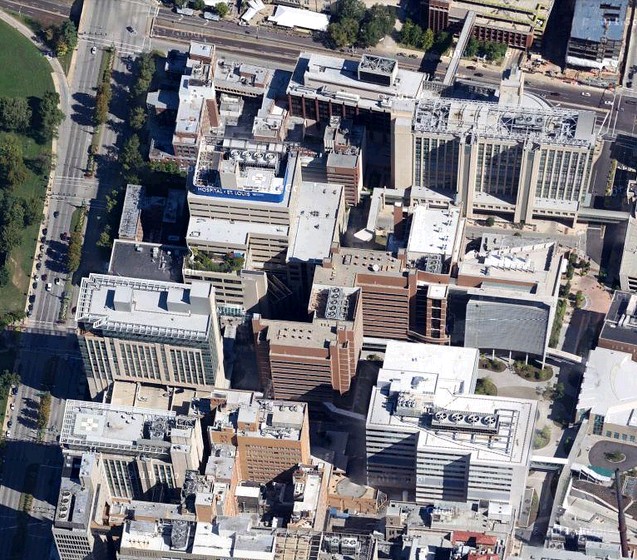 The BJC Healthcare/Washington University Medical Center is planning for another decade of incredible growth. The grandiose sounding number of $1,200,000,000 doesn’t buy as much as you may think, but it will continue the rapid transformation of the medical campus. A similar number was spent over the past 10 years to build BioMed21, EPNEC, Farrell Learning and Teaching Center, two towers fronting Kingshighway, the new genome sequencing center and more.
The BJC Healthcare/Washington University Medical Center is planning for another decade of incredible growth. The grandiose sounding number of $1,200,000,000 doesn’t buy as much as you may think, but it will continue the rapid transformation of the medical campus. A similar number was spent over the past 10 years to build BioMed21, EPNEC, Farrell Learning and Teaching Center, two towers fronting Kingshighway, the new genome sequencing center and more.
What will $1.2B look like? Little has been confirmed, but the continued revitalization effort will initially focus on the northwest corner of campus and buildings along Kingshighway. Queeny Tower will be demolished and replaced.
For anyone unsure, it is necessary that BJC build adjacent to existing hospital assets. A surface parking lot two blocks from the existing emergency room is not a potential site for a hospital bed tower. Proximity is required. This means that demolition will be necessary and may mean that BJC will continue to build up. At the same time, hospital technology and design has changed significantly since Queeny Tower was built in 1965.
The recently completed BioMed21 (bottom right in image above) is the largest on the campus at 700,000 square feet. At a cost of $235M, a couple similarly large projects would consume the $1.2B. The building was constructed to allow additional floors to be added to the northern end and expansion could occur in the next decade. At the center of the medical campus, BJC/WUSM invested in a signature plaza designed by big names: Maya Lin and Michael Van Valkenburgh. The investment may bode well for the future. Althought not perfect, BioMed21 itself and the plaza show that new development need not be utilitarian and uninteresting.

{BJC Plaza with Maya Lin designed fountain}
The long-planned and currently delayed new Shriners Children’s Hospital for the campus is estimated to cost $170M and encompass 247,000 square feet. Although, likely not figured as part of the $1.2B in development, a similar expansion adjacent to Children’s Hospital is very possibly part of the plan.

{rendering of proposed Shriners Children’s Hospital on BJC/WU medical campus}

While the new headquarters includes retail space along Euclid, it appears unlikely that additional retail space will be added to the campus. This remains an obvious shortcoming and it’s difficult to understand how a business such as CVS has not been accommodated near the MetroLink stop, the busiest in the entire system. There are ways to make the campus a better place to work and a more integrated part of the community, but we shouldn’t be surprised if this doesn’t happen.

{Kingshighway Building is likely on the chopping block}
Perhaps the most significant visual change will be the demolition (and presumptive replacement) of Queeny Tower, a defining landmark. With the modified lease of Hudlin Park allowing BJC to build just south of the existing tower, the need to build up may be less than before. With just 15% of Hudlin Park being required to remain green space, there’s plenty of room. The 85% of buildable land could hold a dozen Queeny Towers. However, it’s difficult to image that BJC will replace the third tallest medical building in the US with mid-rise facilities.

{a mock-up of potential BJC expansion}
The twin spire tower shown on the current site of Queeny Tower in the image above is the O’Quinn Medical Tower at St. Luke’s Hospital in Houston, Texas, currently the tallest hospital building in the US and second tallest in the world. Perhaps BJC will be motivated to produce a signature tower at this prominent location. The O’Quinn Tower reaches 29 stories and 477 ft. tall (Queeny Tower measures 321 ft.). The buildings shown on Hudlin Park are duplicates of the towers most recently built fronting Kingshighway several blocks to the north.
Other questions remain. Will BJC request the closure of additional city streets? A quick glance at a map seems to show that this is unlikely, but one can never be sure. Additionally, will historic buildings be preserved? The Shriners Hospital on Euclid and the oldest section of the Central Institute for the Deaf have been slated for demolition. It’s difficult to imagine the McMillan Building, the historic home of the Washington University Medical School would be demolished. No plan has been been released.

{McMillan building – BJC/WUSM}

{detail of historic Shriners Children’s Hospital}
The changes most apparent to the public will be buildings fronting Kingshighway and a new hospital tower, but a significant portion of the $1.2B will be used to renovate and update existing structures. The news that BJC will continue to invest in the Central West End campus is good news and development may add to the density and skyline of the city. In the end, it means more of the same, in the best way.
WUMC Community Unit Plan_Nov 2007
 The BJC Healthcare/Washington University Medical Center is planning for another decade of incredible growth. The grandiose sounding number of
The BJC Healthcare/Washington University Medical Center is planning for another decade of incredible growth. The grandiose sounding number of 
